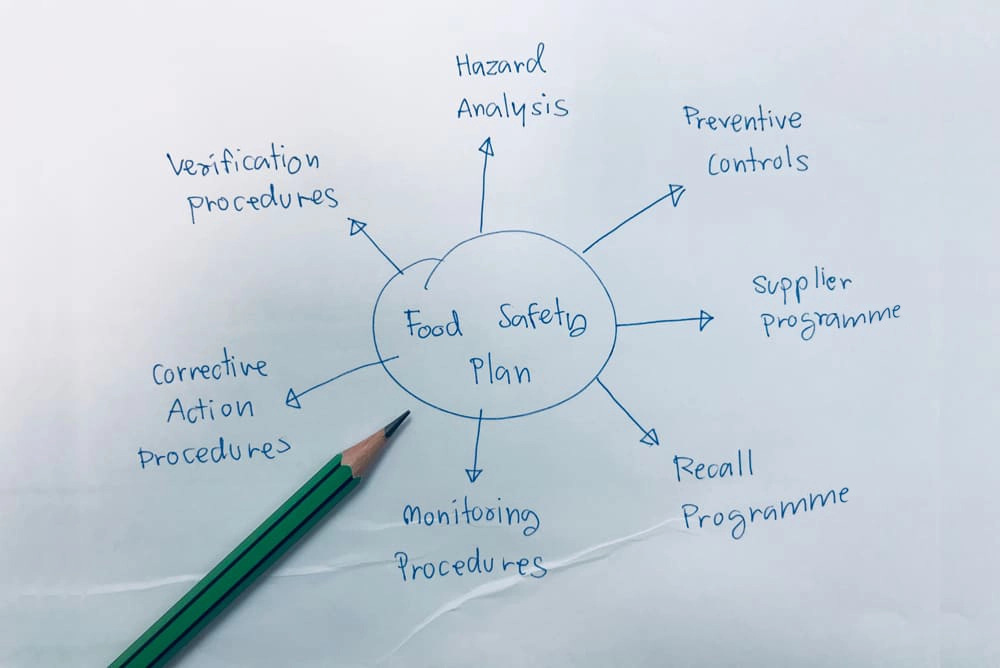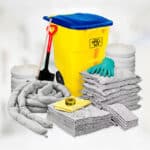
If you run a food business, ensuring your products are safe is one of your most important responsibilities. Your customers must trust that the food they eat is safe, and food safety inspectors expect the same.
The tool food businesses use for this is a HACCP plan – a structured way of showing how you control risks to the food you make, serve or handle.
But what exactly is a HACCP plan? And what goes into one?
This guide explains.
Key Takeaways: HACCP Plans
- A HACCP plan is a legal requirement for all food businesses in the UK.
- It shows how you identify, control and monitor food safety hazards.
- Every plan must follow the seven HACCP principles.
- Free templates and examples are available from the Food Standards Agency (FSA).
What Is HACCP?
HACCP stands for Hazard Analysis and Critical Control Point. This is an internationally recognised food safety system designed to prevent problems.
The concept was actually developed during the 1960s, when NASA was planning the first manned space missions. They couldn’t risk foodborne illness in space, so astronauts’ food needed to be completely safe. To make this happen, food scientists designed the HACCP system.
The reasoning is straightforward:
- Food can be exposed to hazards at many stages, from storage and preparation to cooking and serving
- Instead of relying on end-product testing, HACCP requires you to identify hazards in advance, set controls at the critical steps and monitor those controls continuously
This proactive approach greatly reduces the chance of unsafe food reaching customers (or astronauts).
Food Hygiene Courses
Equip food workers with essential training for their role. Our online food hygiene courses provide an understanding of food safety, HACCP systems and cross-contamination. All courses award independently recognised certificates for proof of training.
Which Businesses Does HACCP Apply To?
In the UK, following HACCP principles is not optional. Food hygiene law requires all food businesses to have a system based on HACCP.
This includes:
- Restaurants and cafes
- Food manufacturers
- Hospitals and care homes
- Caterers and food trucks
- Schools and large kitchens
If you handle, make or serve food, you need a HACCP plan. It’s a practical way to demonstrate your business is food-safety compliant.
What Is a HACCP Plan?
A HACCP plan is the written document explaining how you’re keeping food safe.
At a high level, your plan must cover:
- Food safety hazards at each stage of your process
- Steps you’ve taken to control these hazards
- What you’ll do if something goes wrong
No two businesses are identical, so every HACCP plan is different. A café, a catering van and a food manufacturer will all face different hazards, so they’ll use different controls. That’s why inspectors need to see a plan that reflects your food, your processes and your risks.
What Must Be Included in a HACCP Plan?
Every plan must include the same basic information:
- Who is responsible – the team or person in charge of food safety
- What you make – a description of your food products and how they’re used
- How it is made – a step-by-step flow diagram of your process
On top of this, you then need to fill out details of how you’re keeping food safe in your business. There’s a framework for this, built around seven principles.
The principles of HACCP are:
- Look for hazards – Go through each step of your process and identify what could make food unsafe (bacteria, chemicals, physical objects, allergens, etc.)
- Find the critical control points (CCPs) – Pinpoint the stages where you must stay in control to keep food safe, such as cooking, chilling or cleaning
- Set your limits – Decide the measurable limits that must be met at each CCP, like a minimum cooking temperature or maximum storage time
- Plan how to check – Establish monitoring procedures so you know the limits are being met
- Plan what to do if something goes wrong – Set corrective actions to stop unsafe food from reaching customers
- Double-check your system – Set verification methods, like audits or equipment checks, to confirm your HACCP plan is working
- Keep records – Document your monitoring, corrective actions and verification. This provides proof that you are controlling risks consistently
Taken together, these elements form a complete picture of how your business manages food safety.

How Do You Write a HACCP Plan?
Getting started with a HACCP plan can feel overwhelming, but it’s simply the process of documenting what you do to keep food safe for your customers.
Start with the basic information (who’s responsible, what you make, how it’s made) and then work through the seven principles of HACCP in order. These principles give you a clear framework for identifying risks, deciding where control is essential and proving that your system works.
If you’re still unsure where to start or if your plan is compliant, there are resources available to guide you.
The Food Standards Agency provides free tools, including a HACCP plan template and a HACCP plan example, which can help you apply the principles to your own business. You can find them here.
Do You Need Qualifications to Write a HACCP Plan?
You don’t need formal qualifications to write a HACCP plan for your business.
However, training is strongly recommended. Writing a plan involves technical steps such as identifying hazards, setting critical limits and creating monitoring procedures. Without training, you may end up with a plan that looks good on paper but fails in practice.
However, it’s important to note that those following your plan need to be trained, too.
Everyone who handles food must be suitably trained in safe practices, including hygiene, temperature control and preventing cross-contamination.
Who Checks HACCP Plans?
HACCP plans are checked by Environmental Health Officers (EHOs) during food safety inspections. Their job is to make sure your business has a suitable plan in place and that it’s actually being followed.
When reviewing your HACCP plan, EHOs will expect to see:
- A clear description of your food processes
- Evidence that hazards have been identified and controls are in place
- Records showing that monitoring and corrective actions are carried out
- Staff who understand the plan and know their responsibilities
- Training records that prove staff have received appropriate food safety training
Inspections aren’t just about paperwork. Officers will also watch to see if food is stored, prepared and handled in line with your HACCP plan.
If your plan isn’t being followed (or is missing entirely), inspectors will take enforcement action. This starts with warnings and orders to make improvements. In serious cases, such as inadequate plans or incomplete training records, they can issue fines or force your business to close.
Food Safety Training
HACCP is only effective if your staff understand what it means. If you don’t train your staff, there’s a risk of unsafe food reaching your customers – even with a plan in place.
We offer a range of online courses on food safety covering essential topics such as food handling, cross-contamination, temperature control and applying HACCP principles in day-to-day work.
These courses are ideal for food handlers, food manufacturing workers, hospitality staff, catering teams and supervisors.
Train your team now so your HACCP plan works in practice, not just on paper.





















